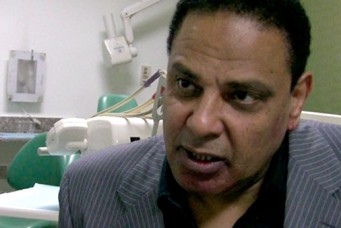Welcome to the Second Industrial Revolution!
How maker spaces are booming in Egypt and counties in sub-Saharan Africa

Students use the Ultimaker, a 3D-printing machine, to make various sized and shaped creations for school work. Erin Hayes
Looking for a job? Join the maker movement, a new trend sweeping North Africa and particularly Egypt, which takes a different approach to finding jobs. Dubbed a “second industrial revolution,” makerspaces allow members to develop their skills in an innovative space, with the potential of creating business and employment opportunities.
Makerspaces are collaborative environments where would-be creators and inventors find access to technological resources that would often otherwise be prohibitively expensive, as well as membership in a community of other makers. Egypt’s growing maker movement focuses on giving entrepreneurs opportunities to build up their technical knowledge and products rather than ameliorating the employment market. For example, Fab Lab Egypt—the Middle East’s first makerspace founded in 2012 and an accredited member of the Massachusetts Institute of Technology Fab Lab global network (Fab coming from the word “fabrication”)—began as an educational space that offered workshops and programs to people interested in digital fabrication. It later developed into a broad organization that, in addition to serving local makers, hosts three resident start-ups, provides consultations and trainings for businesses, and seeks to spread the maker culture across Egypt.
For more experienced entrepreneurs, Qafeer Makerspace in Cairo aids hardware start-ups in creating prototypes for their products. In Alexandria, Karakeeb Makerspace aims to spread knowledge to people without engineering backgrounds, particularly targeting underprivileged youth.
The American University in Cairo itself hosts a makerspace that prides itself on being the first fully educational Fab Lab, which follows a hands-on model. There is no shortage of creations when using the lab’s machines. Students have used the Ultimaker 3D to print items ranging from a model airplane to a lamp composed of three-dimensional prisms of various sizes. A sleek, functional fidget spinner was created with a simple laser cutter. By educating students on how to make their own products, AUC’s FabLab is taking “a step forward toward making more makers,” say its lab managers—an essential component of the movement, which values peer-to-peer learning and idea sharing.
The impact of the makerspace scene on the Egyptian economic ecosystem has been noticeable. Emerging after the 2011 uprising, makerspaces in Egypt boomed to twenty-one spaces spanning six governorates by December 2017. This is a considerable achievement compared to nine and five makerspaces in Morocco and Tunisia, respectively. According to Nagham El Houssamy, a senior researcher for AUC’s Access to Knowledge for Development Center (A2K4D), there is a definitive link between the makerspace and the skills that people gain there, which could help them launch a career or land a job. Furthermore, the movement seeks to spread its benefits beyond the confines of Egypt’s major cities. Innovations such as Fab Lab on Wheels, a mobile makerspace that brings tools and expertise to governorates outside of Cairo and Alexandria, seek to make the movement and its potential for job creation inclusive.
The movement is not without its limitations, however. One significant challenge is a lack of governmental support. Simple fixes have the potential to make a difference in the nascent movement, but as of yet, policies supporting the movement are not in place. High customs can make the cost of heavy machinery such as 3D printers and computer numerical control milling machines exorbitant. Furthermore, obtaining licensing and registration for makerspaces is difficult because there is currently no legal category for makerspaces.
This lack of governmental buy-in is not the case elsewhere, especially in developing countries in sub-Saharan Africa, where the maker movement has found relative success. In South Africa, for example, makerspaces enjoy high levels of government support and investment. The Open African Innovation Research Partnership found that, of sixteen makerspaces in South Africa, five derived at least some of their funding from government sources, and two were completely governed and managed by the government.
El Houssamy’s goal is that makerspaces reach policymakers, but one prerequisite is the growth of the movement itself. “The more the labor,” she told the Cairo Review, “the more we reap the fruits of the labor, and the more policymakers will see its benefits more clearly and shift policies to better serve it.” The best way to actualize this, El Houssamy noted, is for people to get involved, visit makerspaces, and learn a new skill. After all, she added: “You never leave with less than what you went in with.”
Subscribe to Our Newsletter




